Naomasa Yamamoto (1), Yuichi Koike (2), Katsuyuki Kumano (3), Norifumi Yonehara (4)
Dept. of Biochemistry (1), Dept. of Drug Metabolism and Clinical Pharmacokinetics (2), Dept. of Pharmacology (4), School of Pharmaceutical Sciences, Ohu University, 31-1 Misymido, Tomitamachi, Koriyama, Fukushima, 963-8611 Japan. Japan System Planning Co., Ltd. (3), 2-21-12 Sasazuka, Shibuya-ku, Tokyo, 151-0073 Japan.
Introduction
Accumulation of oxidative stress elevates physiological aberrances such as aging, atherosclerosis, hypertension, obesity, myocardial infarction, and stroke. It is desired to reduce the oxidative stress in blood as much as possible. We have developed an apparatus named Yubi-MR (Japan System Planning Co.) to reduce oxidative stress in blood by radiation of electromagnetic waves to “Yubi” meaning a finger in Japanese. Yubi-MR mimicked a NMR-Pipetector which is widely used as a dehydrator of Fe(III) ions by reduction through inducing negatively charged water. In this study, we demonstrated that Yubi-MR reduced dROM after irradiating a finger for 10 min. On clinical trials undertaken with mice, Yubi-MR radiation suppressed their behaviors which resulted in a prolongation of their resting time. Thus, Yubi-MR is the oxidative stress reducer, possibly applicable to clinical therapeutic use for reducing oxidative stress in patients with oxidative-related diseases.
Methods
Blood donors:This experiment has been cleared by the ethics committee, Ohu University according to, and in compliance with the declaration of Helsinki. After 9 healthy volunteers before/after radiation by the Yubi-MR, plasma was collected by centrifugation.
Measurement of dROM and BAP: A reactive oxygen metabolites (d-ROMs) and a biological antioxidant potential (BAP) in the plasma were measured by FRAS4 (Wismerll).
| ROMs(U CARR) | ROMs(mg H2O2/dL) | Oxidative stress(severity) |
|---|---|---|
| 250 – 300 | 20.08 – 24.00 | Normal Range |
| 300 – 320 | 24.08 – 25.60 | Border-line range |
| 321 – 340 | 25.68 – 27.20 | Low level oxidative stress |
| 341 – 400 | 27.28 – 32.00 | Middle level of oxidative stress |
| 401 – 500 | 32.08 – 40.00 | High level of oxidative stress |
| > 500 | > 40.00 | Very high level of oxidative stress |
Oxidative Stress in Blood

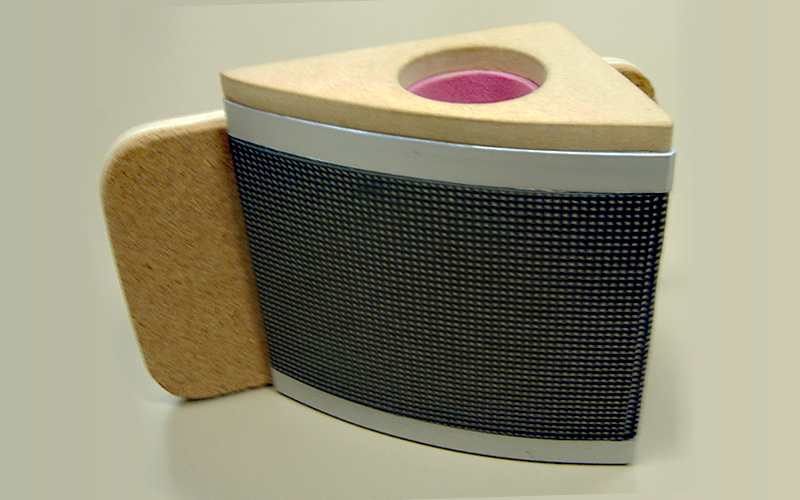

Yubi-MR is a perfectly engineered and designed apparatus with a single well which allows a human finger or thumb to be inserted for exposure to the electric magnet waves. Twelve sections of blackbodies made from ceramics are embedded in the surrounding wall in 3 lines from top to the bottom ( See Illustration ). There are a couple of the Wingler-magnets in array which are placed in front of the blackbodies. The blackbodies will emit specific electromagnetic waves, and then the waves are sharpened to become a certain length to induce the NMR reaction by passing through the Wingler-magnet array. The Yubi-MR does not contain any radioisotopes or harmful materials.
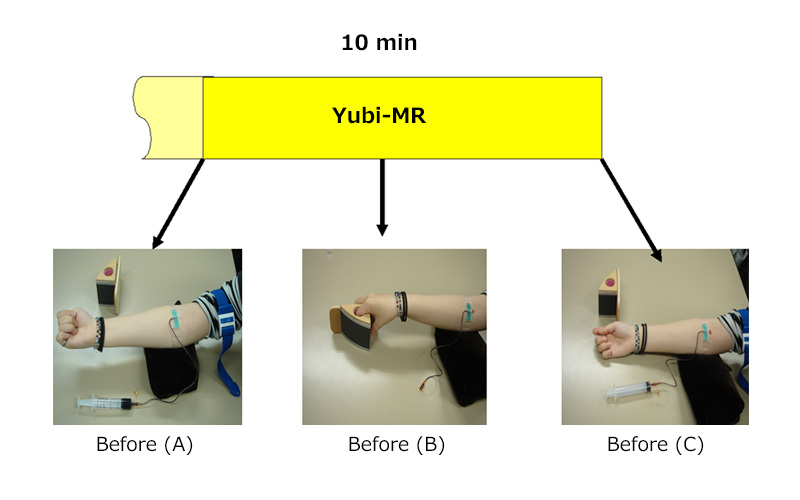
Blood was taken from a donor (A). A finger from the same donor was exposed to the Yubi-MR radiation for 10 minutes without removing the catheter which was used for the purpose of taking the blood sample, and then the radiation was stopped. The blood sample in the catheter (about 1ml ) was removed and the collected subsequent 2.5 ml blood.
Monitoring mouse behavior: Four mice were treated with Yubi-MRm for describing time in Table 2. Dummy MRm (Removed blackbody from Yubi-MRm) was used instead of Yubi-MRm as a control. The behavior of a mouse was monitored after exposure to the Yubi-MR radiation (Figure 3 and 4 ).
| Experiment | Number | No. of Exp. | Accumulation | Radiation |
|---|---|---|---|---|
| No.1-1 | 8 | 11x-81x | 1min | 10 min |
| No.1-2 | 8 | 91x-103x | 15 min | 30 min |
| No.2 | 8 | 104x-150x | 15 min | 30 min |
| No.3 | 8 | 160x-300x | 15 min | 30 min |
| No.4-1 | 8 | 310x-390x | 15 min | 30 min |
| No.4-2 | 8 | 400x-430x | 15 min | 10 min |
| No.5 | 8 | 450x-590x | 1 min | 10 min |
| No.6 | 8 | 600x-770x | 1 min | 1 min |
| No.7 | 8 | 800x-890x | 1 min | 1 min |
| No.8 | 8 | 900x-930x | 1 min | 1min |

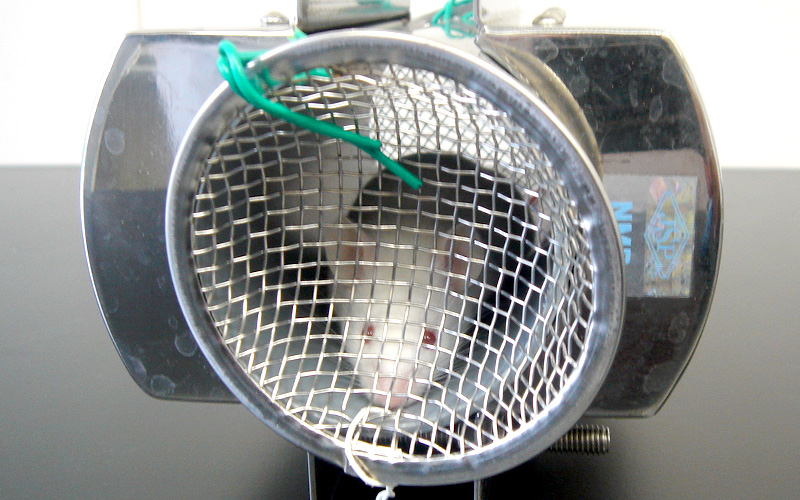
Yubi-MR is fundamentally the same device as the NMR Pipetector technology which has been designed for radiation to a mouse. A NMR Pipetector mounted on a section of pipe (5 cm diameter x 20cm in length ) which had both ends of the pipe covered with a metal net. The mouse was released in it for a measuring period of time.

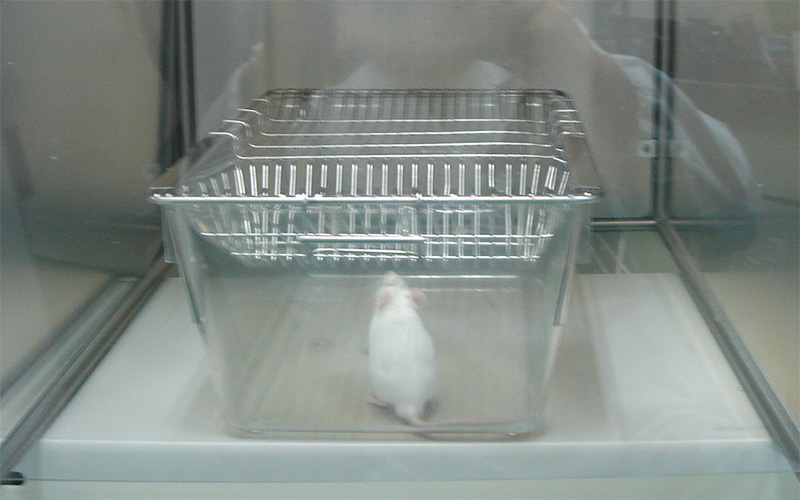
SuperMex (Muromach Kikai) has eight channel sensors for the detection of IR which comes out from the mice who are moving freely in the cages, and it can convert them to a score as athletic point-values. SuperMex can accumulate the scores by each minute and can record subsequently for 72 hours.
Resting time: Score ” “zero” implies that the mouse dose not move during the measuring period by SuperMex. In order to calculate the resting time in 24 hours, all the zero-scores were summarized, and were expressed as minutes.
Statistic analysis: Paired t-test was used for analysis.
Results
Effect of Yubi-MR radiation on dROM and BAP
Data on dROM and BAP in heparinized plasma from 9 donors were summarized in Table 1. D-ROM value was 249.6±6.7 (mean ±SE) before the irradiation. After the irradiation with electromagnetic waves for 10 min at 1.0 x 10-3 dB V/m x 3 intensity, d-ROM significantly dropped to 230.4±14.8 (mean±SE) (p<0.01). In contrast, BAP was not changed at all (before/after = 2401.1 ±37.5 vs 2401.2±37.0, mean ±SE). The results of d-ROMs test expressed as concentration unity, CARR U indicate the blood levels of hydroperoxides which directly parallel with the levels of free radicals. Reference value in healthy people are estimated to be 250-300 CARR U (20.08-24.00 mg/dL of H2O2). One CARR unit corresponding to 0.08 mg H2O2. The values obtained here were in a normal range, suggested the they are all healthy individuals. Even under the normal condition, Yubi-MR radiation for 10 min could quenches approximately 0.16 mg H2O2 in the body.
| Human | BAP Before | dROM Before | BAP After | dROM After | BAP/dROM Before | BAP/dROM After |
|---|---|---|---|---|---|---|
| No.1 | 2223 | 364 | 2214 | 323 | 6.107 | 6.854 |
| No.2 | 2224 | 237 | 2213 | 219 | 9.383 | 10.105 |
| No.3 | 2486 | 222 | 2448 | 188 | 11.198 | 13.021 |
| No.4 | 2491 | 241 | 2416 | 231 | 10.336 | 10.458 |
| No.5 | 2537 | 266 | 2503 | 261 | 9.537 | 9.590 |
| No.6 | 2381 | 201 | 2451 | 186 | 11.845 | 13.177 |
| No.7 | 2444 | 267 | 2404 | 224 | 9.153 | 10.732 |
| No.8 | 2377 | 193 | 2468 | 187 | 12.316 | 13.197 |
| No.9 | 2447 | 256 | 2494 | 255 | 9.558 | 9.780 |
| Average | 2401.111 | 249.666 | 2401.222 | 230.44* | 9.937 | 10.761 |

Effect of Yubi-MR on BAP/dROM was observed. Ratio of BAP/dROM was significantly increased after Yubi-MR treatment to humans (left) and the mouse (right).
Effect of Yubi-MRm on mouse behavior: Normal mice (n=64) were grouped into two groups with Yubi-MR treatment and a dummy device treatment (control). Behavior of the mice were assessed by SuperMex and expressed as point/min. Yubi-MR significantly slowed down the behavior of the movements of the mice (p<0.05) (Table 3).
| Yubi-MRm (Point/min) | Dummy device (Point/min) |
|---|---|
| 48.7 ± 8.3 | 52.7±7.7 |
| Mean±SD | Mean±SD |
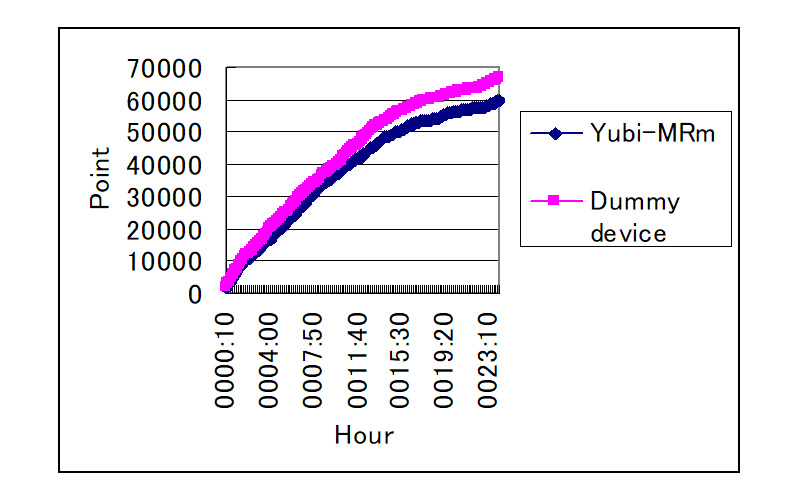
Movement of the mouse (points) were integrated from start to 23 hours. Yubi-MR (blue line vs control pink line) potentially suppressed the behavior of the mouse.

The Yubi-MRm significantly increased the resting time compared to the dummy device (solid column). The mice (n=4) were subsequently treated with opposite device (hatched column).
Discussion
Radiation with Pipetector/Yubi-MR to water increases negative-charged water that can provide free-electrons enough to reduce Fe(III) ions to Fe(II) ions. Yubi-MR might function in a similar way in the blood, resulting in reduction of oxidative stress (dROM). In our preliminary survey about effect of Yubi-MR on human sleep, Yubi-MR induces being sleepy, suggested that the reduction of blood causes suppression of behavior. We hypothesized that Yubi-MR influences animal behavior such as resting time. We demonstrated that Yubi-MR(m) radiation prolonged the resting time of the mice, however, the mechanism of the prolongation of the resting time is still unclear. The accumulation of oxidative stress in the blood induces sleep (xx). However, the removal of oxidative stress may help to sleep easily. The relation between oxidative stress and sleep is therefore clarified.
Conclusion
Yubi-MR is the first oxidative stress-reducer, possibly applicable to clinical therapy for patients with oxidative stress-related diseases.
